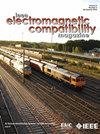一种人致静电放电的原位表征方法
IF 2.5
3区 计算机科学
Q3 ENGINEERING, ELECTRICAL & ELECTRONIC
IEEE Transactions on Electromagnetic Compatibility
Pub Date : 2025-03-05
DOI:10.1109/TEMC.2025.3544120
引用次数: 0
摘要
电子产品受到静电放电(ESD)影响的概率取决于设备受到静电放电的概率和电压水平。通过确定该统计概率,可以进行产品风险评估,并选择适当的ESD测试级别,以确保达到目标的现场可靠性。获取ESD的必要统计信息需要能够检测和量化其参数的方法。传统的ESD检测方法主要是静止的,需要参考电位,缺乏对便携式设备和可穿戴设备的适应性。本文介绍了一种基于体表电场和磁场测量的新型便携式原位检测方法。该方法集成了一个可穿戴式ESD传感器,能够检测放电事件,估计电压和电流水平,并区分人体皮肤和人体金属放电。该传感器的设计允许对人的复杂ESD环境进行表征,对现有方法进行了重大改进。此外,通过与移动应用程序的集成,首次可以通过用户问卷详细分析放电场景。本文章由计算机程序翻译,如有差异,请以英文原文为准。
A Method for In Situ Characterization of Human-Induced ESD
The probability of electronic products being affected by electrostatic discharge (ESD) depends on the probability of the device being subjected to ESD and the voltage level. By determining this statistical probability, product risk assessment, and the selection of appropriate ESD test levels can be performed to ensure the targeted field reliability is reached. Obtaining the necessary statistical information about ESD requires methods that can detect and quantify its parameters. Traditional ESD detection methods are predominantly stationary, requiring reference potential, and lack adaptability for portable devices and wearables. This article demonstrates a novel, portable in situ detection method based on on-body electric and magnetic field measurements. The proposed method integrates a wearable ESD sensor, capable of detecting discharge events, estimating voltage and current levels, and differentiating between human skin and human metal discharges. This sensor's design allows the characterization of the complex ESD environments of a person, offering a significant improvement over existing methods. Additionally, integration with a mobile application enables detailed analysis of the discharge scenario through user questionnaires for the first time.
求助全文
通过发布文献求助,成功后即可免费获取论文全文。
去求助
来源期刊
CiteScore
4.80
自引率
19.00%
发文量
235
审稿时长
2.3 months
期刊介绍:
IEEE Transactions on Electromagnetic Compatibility publishes original and significant contributions related to all disciplines of electromagnetic compatibility (EMC) and relevant methods to predict, assess and prevent electromagnetic interference (EMI) and increase device/product immunity. The scope of the publication includes, but is not limited to Electromagnetic Environments; Interference Control; EMC and EMI Modeling; High Power Electromagnetics; EMC Standards, Methods of EMC Measurements; Computational Electromagnetics and Signal and Power Integrity, as applied or directly related to Electromagnetic Compatibility problems; Transmission Lines; Electrostatic Discharge and Lightning Effects; EMC in Wireless and Optical Technologies; EMC in Printed Circuit Board and System Design.

 求助内容:
求助内容: 应助结果提醒方式:
应助结果提醒方式:


